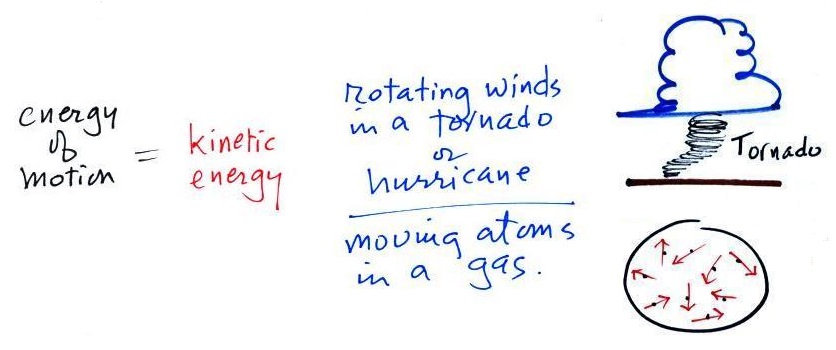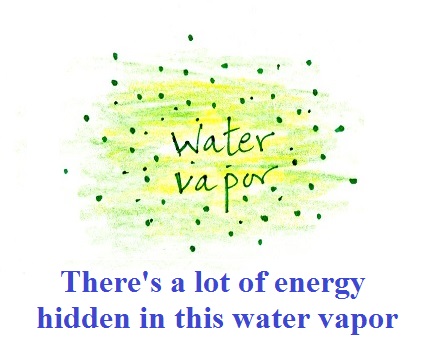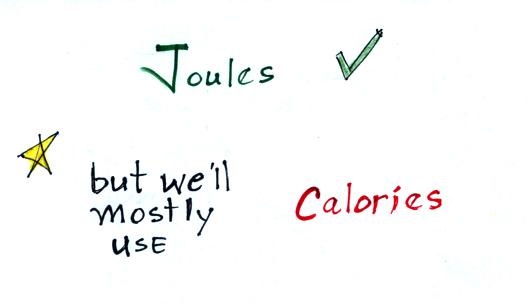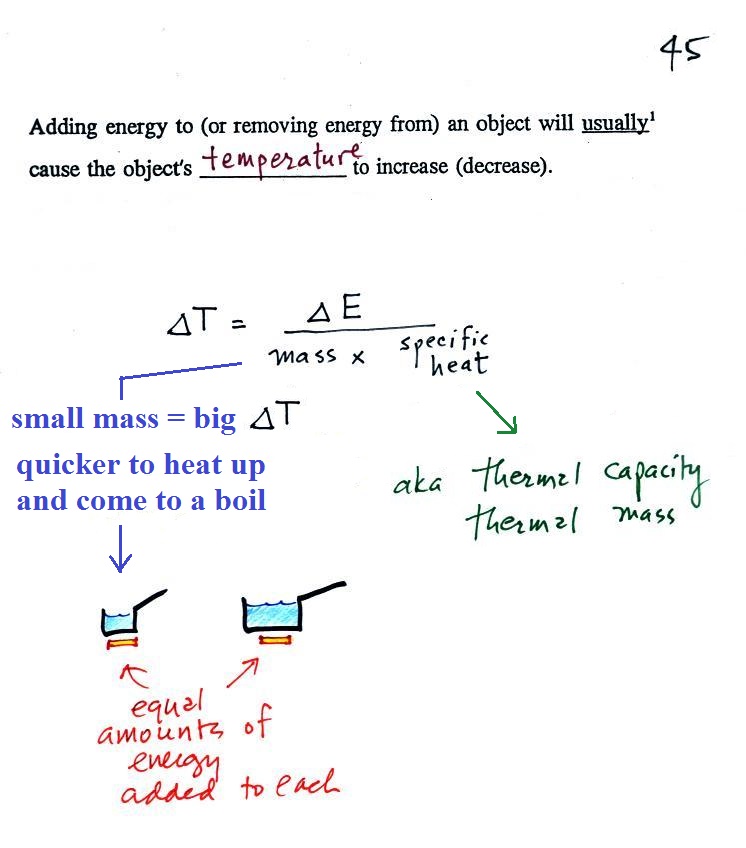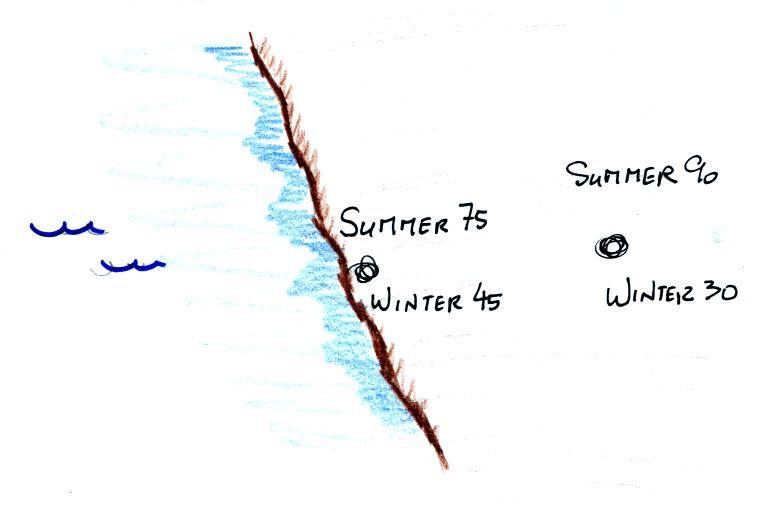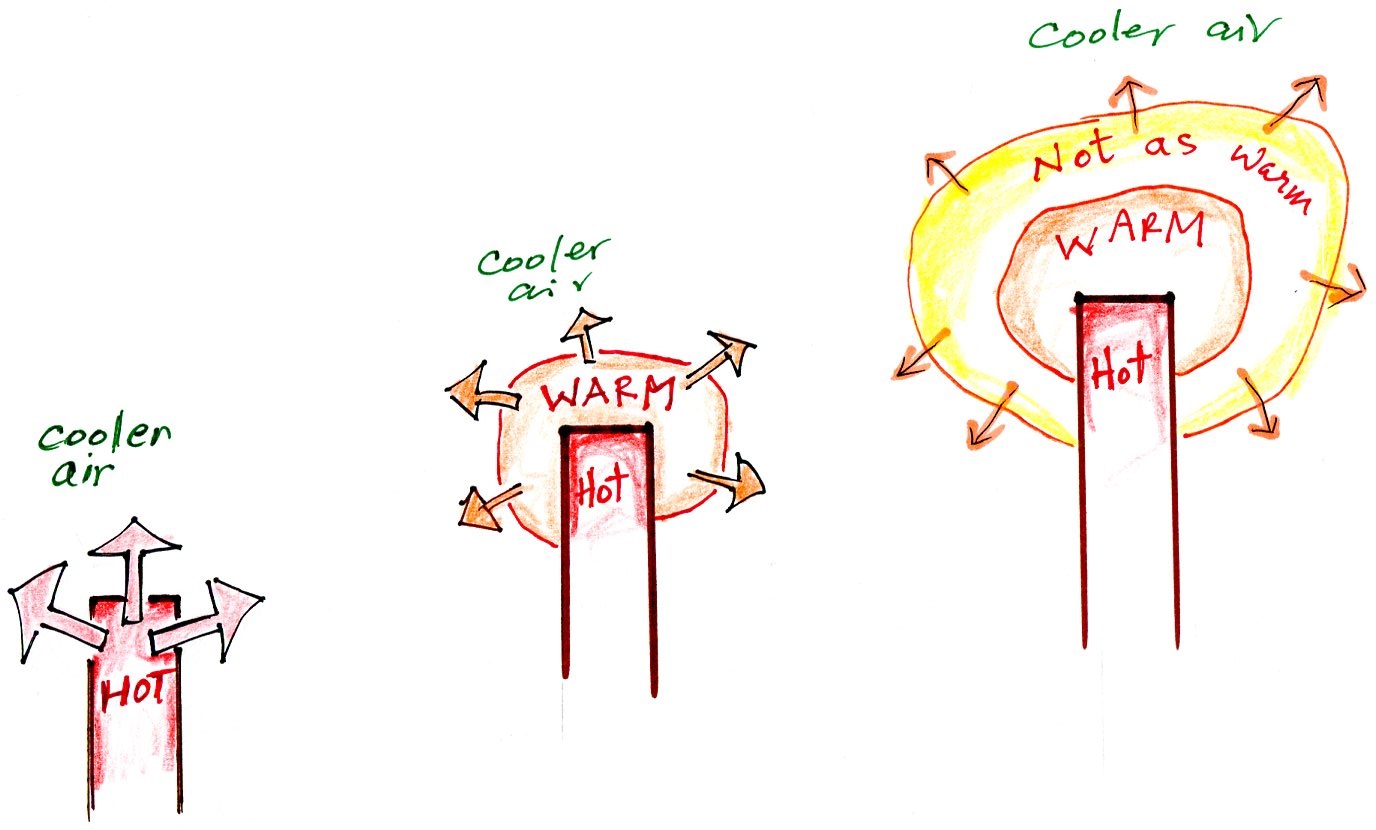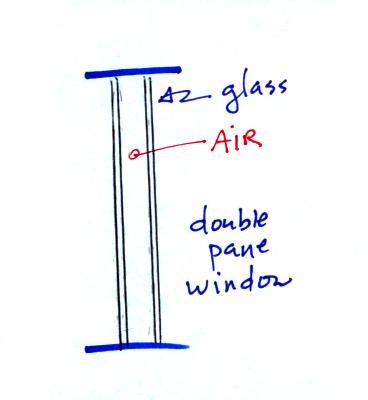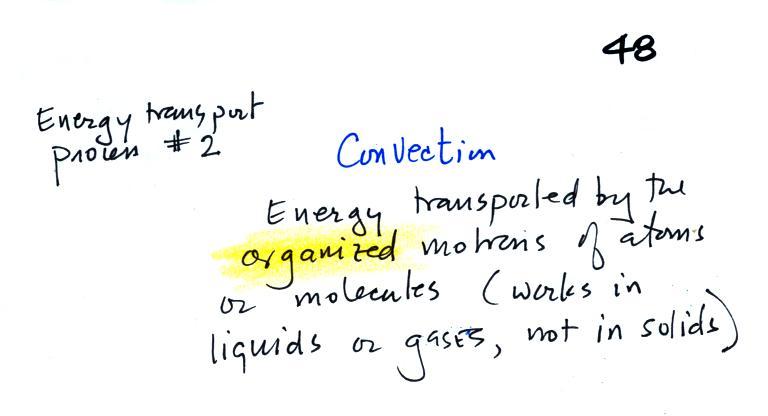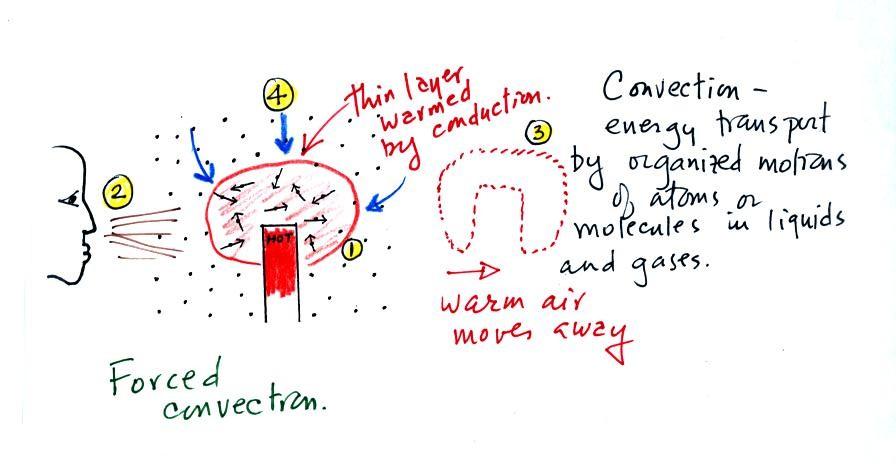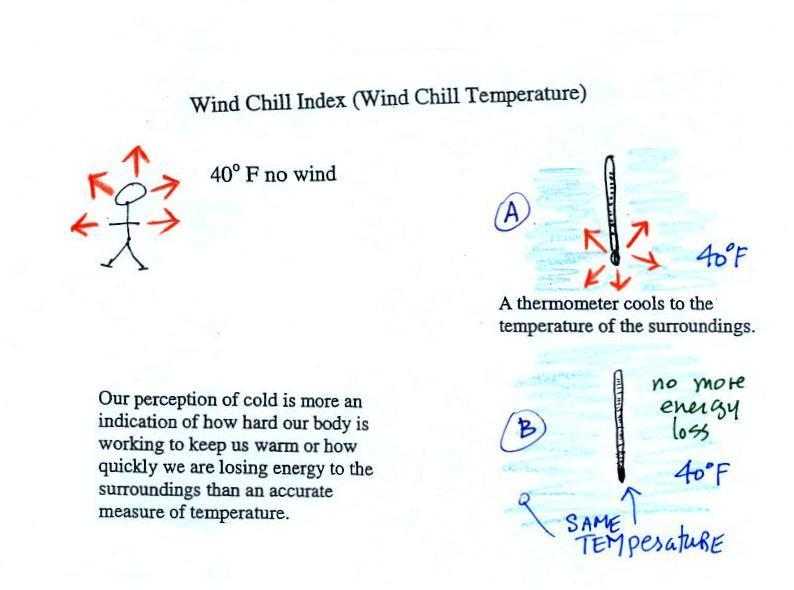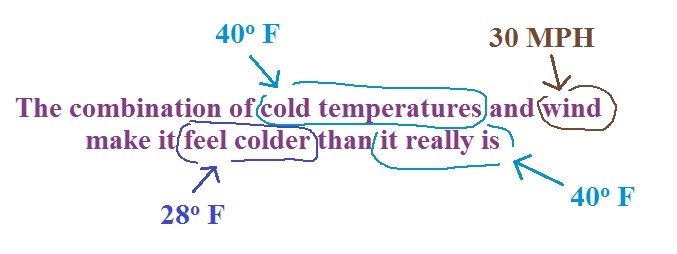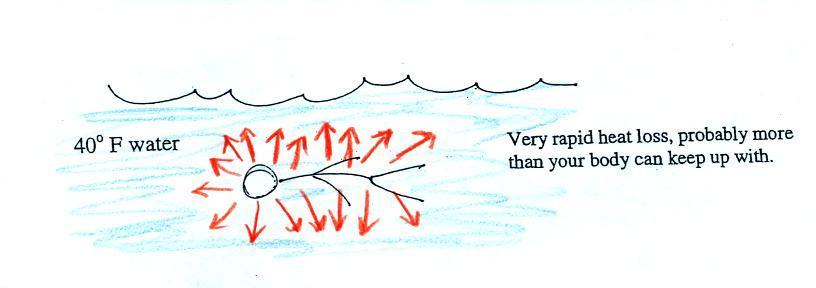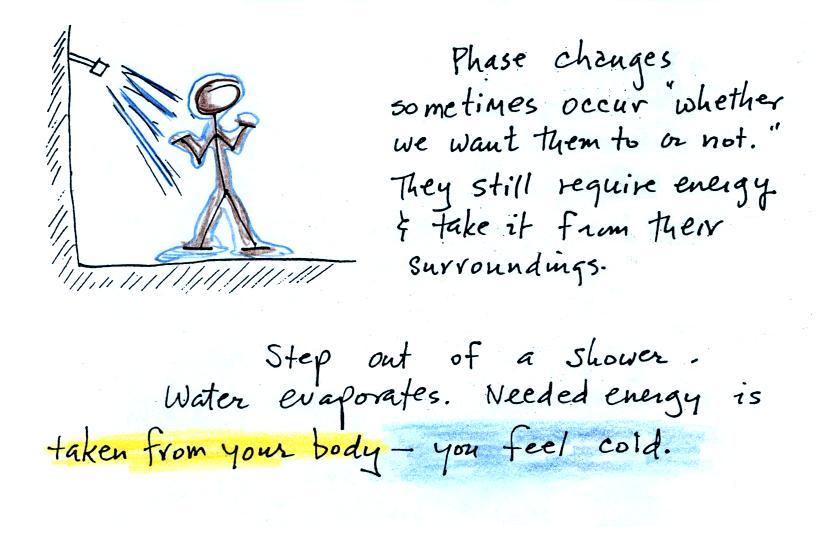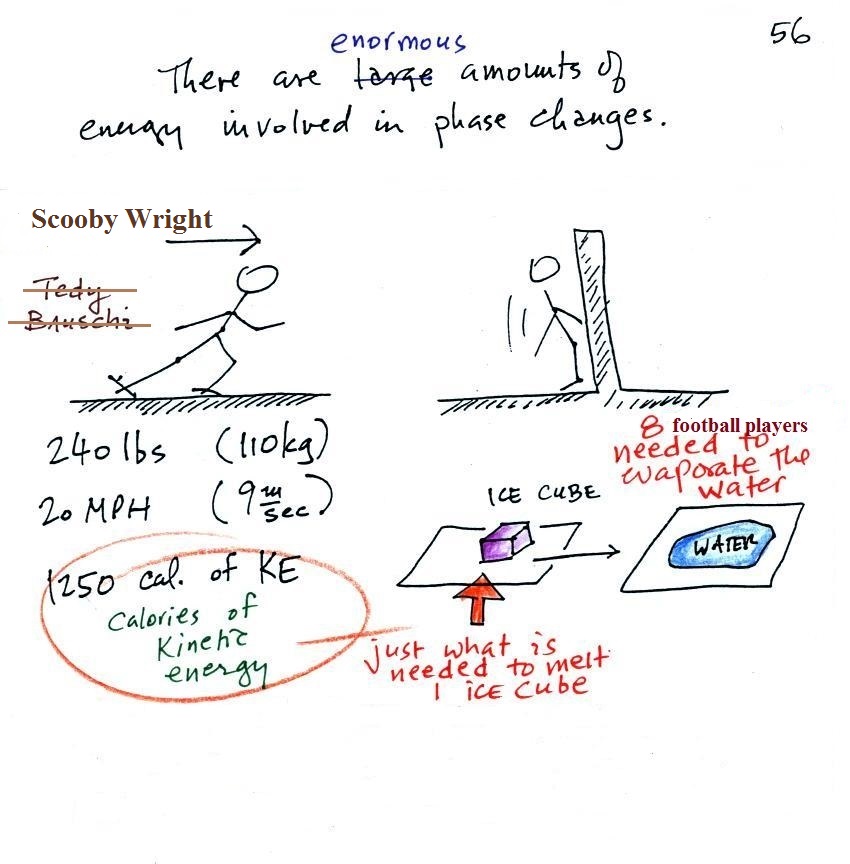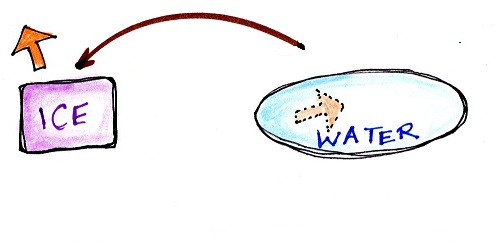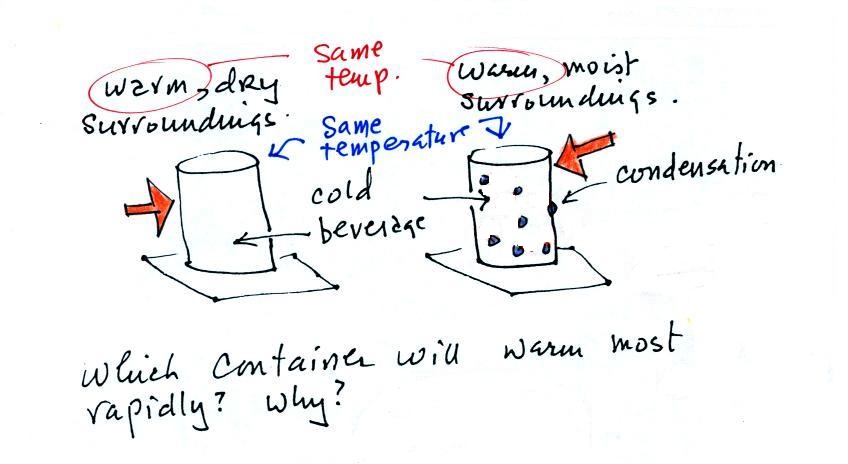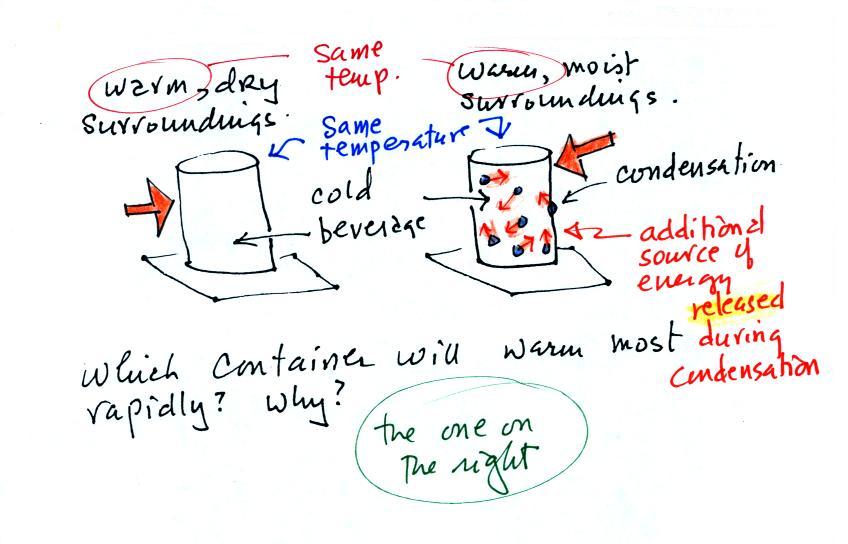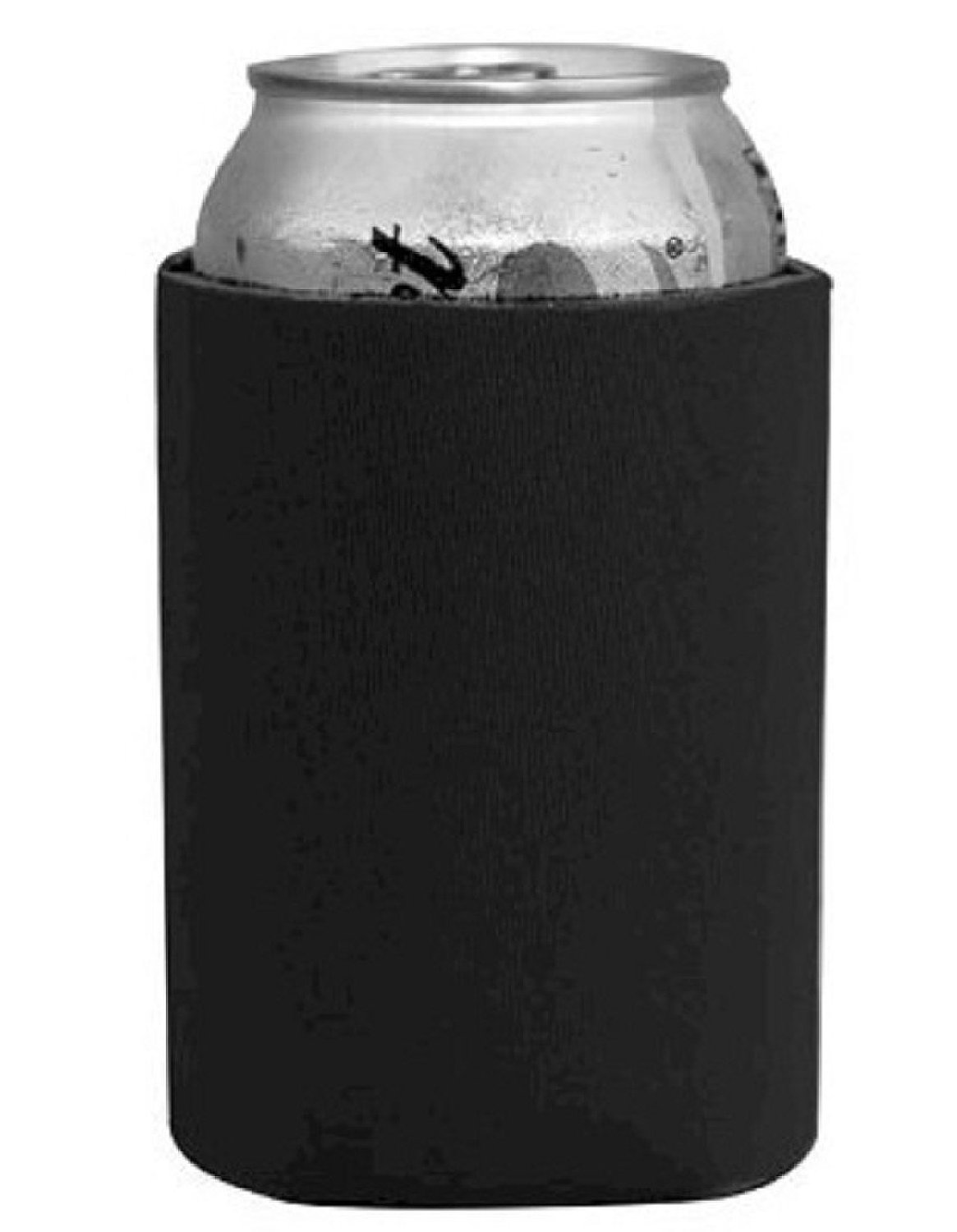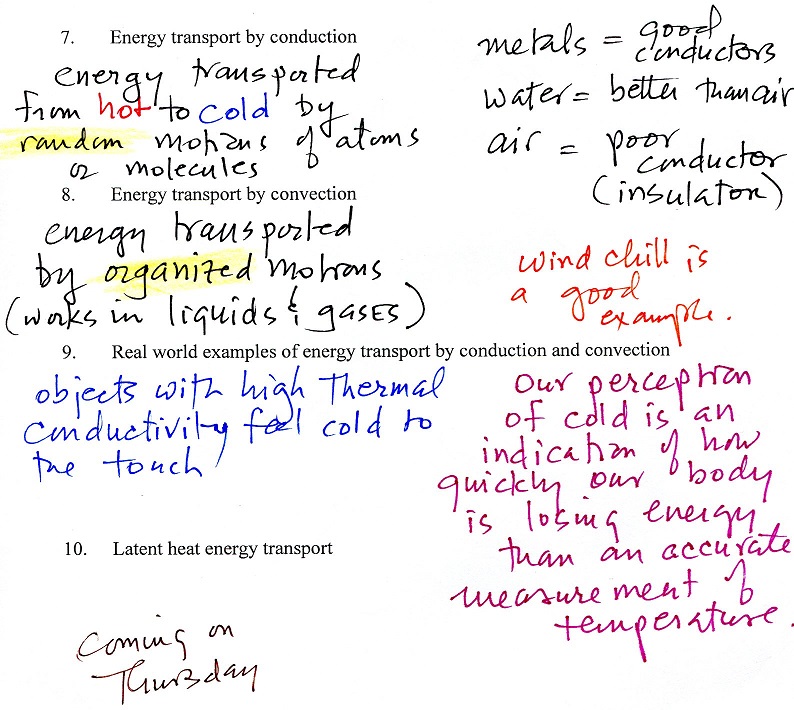Kinetic
energy is energy of motion.
Some examples (both large and microscopic scale) are
mentioned and sketched above. This is a
relatively easy to visualize and understand form of
energy.
Radiant energy is a very important form
of energy that was somehow left off the original list in the
ClassNotes . Electromagnetic radiation is
another name for radiant energy. Sunlight is an
example of radiant energy. It's something that
we can see and feel (you feel warm when you stand in
sunlight). Something that is not quite so obvious is
that everyone in the classroom is emitting radiant
energy. This is infrared light, an invisible form of
radiant energy. And actually it's not just the people;
the walls, ceiling, floor and even the air in the classroom
are also emitting infrared light. We can't see it and,
because it's there all the time, I'm not sure whether we can
feel it or not.
Latent heat energy is
an, important, under-appreciated, and rather
confusing type of energy. The word latent
refers to energy that is hidden. That's part
of the problem. Another part of what
makes latent heat energy hard to visualize and
appreciate is that the energy is hidden or stored in
water vapor or water - that seems an unlikely place
to find energy.
2. We'll get the topic of energy
units out of the way
Joules
are the units of energy that you would probably
encounter in a physics class. Your
electric bill shows the amount of energy
that you have used in a month's time, the
units are kilowatt-hours.
We'll usually be using calories as units of
energy. 1 calorie is the energy need to warm 1
gram of water 1 C (there are about 5 grams of water
in a teaspoon).
3.
Temperature provides a measure of
the average kinetic
energy of the atoms or molecules in a
material.
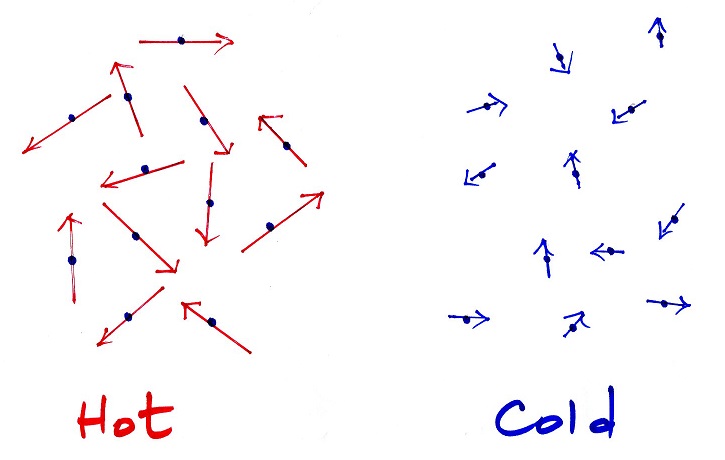
The atoms or
molecules inside the warmer object will be moving
more rapidly (they'll be moving freely in a gas,
just "jiggling" around while still bonded to each
other in a solid). Since kinetic
energy is energy of motion, temperature gives you
an idea of the average speed of the moving atoms
or molecules in a material.
You need to be careful what temperature
scale you use when using temperature as a measure
of average kinetic energy. You must use the
Kelvin temperature scale because it does not go
below zero (0 K is known as absolute zero). The
smallest kinetic energy you can have is zero
kinetic energy. There is no such thing as
negative kinetic energy.
There
are three temperature scales that we might have
occasion to use in this class. They're
shown below. There are two temperatures
that you should try to remember for each
scale.
The boiling and freezing points of
water on both the Celsius and the Fahrenheit scales (the
freezing point of water and the melting point of ice are
the same). Remember that the Kelvin scale doesn't go
below zero. 0 K is referred to as absolute zero,
it's as cold as you can get. A nice round number of
the average temperature of the earth is 300 K, that's the
last temperature value to remember.
Here's some additional temperature data that I'm
including just in case you're interested.
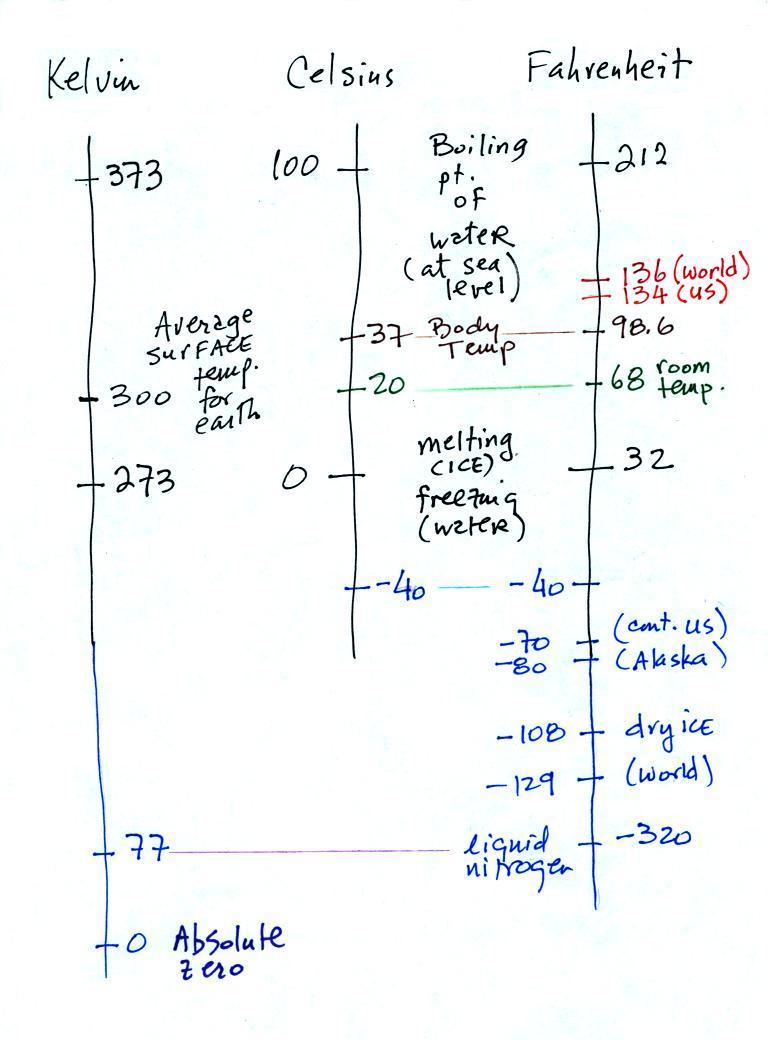
You certainly don't need to try to
remember all these numbers. The world high
temperature record value of 136 F above was measured in
Libya at a location that was only about 35 miles from
the Mediterranean coast. Water, as we have seen,
moderates climate so it seemed odd that such a high
temperature would have been recorded there. The
World Meteorological Organization recently decided the
136 F reading was invalid and the new world record is
the 134 F measurement made in Death Valley.
The continental US cold temperature record of -70 F
was set in Montana and the -80 F value in Alaska.
The world record -129 F was measured at Vostok station
in Antarctica. This unusually cold reading was the
result of three factors: high latitude, high altitude,
and location in the middle of land rather than being
near or surrounded by ocean (again water moderates
climate, both hot and cold).
Liquid nitrogen is very cold but it is still quite a
bit warmer than absolute zero. Liquid helium gets
within a few degrees of absolute zero, but it's
expensive and there's only a limited amount of helium
available. So I would feel guilty bringing some to
class and I don't think it would look any different than
liquid nitrogen.
4. Energy, temperature, and specific
heat
(p. 45 in the ClassNotes)
When you add energy to an object, the object will usually
warm up (or if you take energy from an object the object
will cool). It is relatively easy to come up with an
equation that allows you to figure out what the temperature
change will be (this is another equation I'll try to
remember to write on the board before the next quiz -
try to understand it, you don't have to memorize it).
The temperature change, ΔT, will first depend on how
much energy was added, ΔE. This
is a direct proportionality, so ΔE is
in the numerator of the equation (ΔE
and ΔT are both positive when energy
is added, negative when energy is removed)
When you add equal amounts of energy to large and small
pans of water, the water in the small pan will get
hotter. The temperature change, ΔT,
will depend on the amount of water, the mass. A small
mass will mean a large ΔT, so mass
should go in the denominator of the equation.
Specific heat is what we use to account for the fact that
different materials react differently when energy is added
to them. A material with a large specific heat will
warm more slowly than a material with a small specific
heat. Specific heat has the same kind of effect on ΔT
as mass. Specific heat is sometimes called "thermal
mass" or "thermal capacity." It might
be useful to think of specific heat as being thermal
inertia - a substance with high specific heat, lots of
thermal inertia, will be reluctant to change temperature.
Here's an important example that will show the effect of
specific heat (middle of p. 45).
Equal amounts of energy (500 calories) are
added to equal masses (100 grams) of water and soil.
We use water and soil in the example because most of the
earth's surface is either ocean or land. Before we do the
calculation, try to guess which material will warm up the
most. Everything is the same except for the specific
heats. Will water with its 4 times larger specific
heat warm up more or less than the soil?
The details of the calculation are shown below.
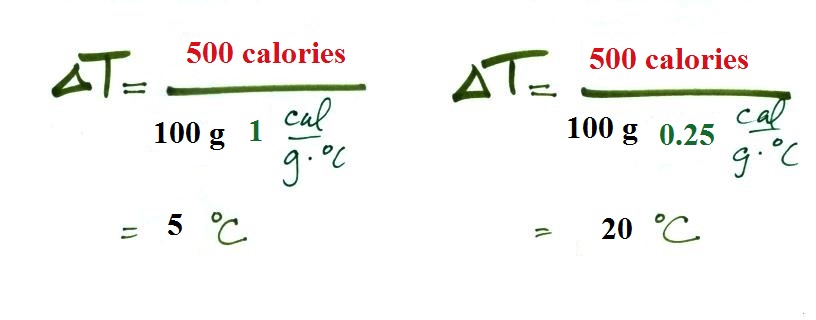
With its higher specific heat, the
water doesn't heat up nearly as much as the soil.
If we had been removing energy the wouldn't cool off as
much as the soil would.
5. Water moderates climate
These different rates of warming of water and soil have
important effects on regional climate.
Oceans moderate the climate. Cities near a large
body of water won't warm as much in the summer and won't
cool as much during the winter compared to a city that is
surrounded by land. Water's ΔT
is smaller than land's because water has a higher
specific heat.
The yearly high and low monthly average temperatures are
shown at two locations above. The city on the coast
has a 30o F annual range of temperature
(range is the difference between the summer and winter
temperatures). The city further inland (assumed to be
at the same latitude and altitude) has an annual range
of 60o F. Note that both cities have the
same 60o F annual average
temperature.
Water moderates climates - it reduces the difference
between summertime high and wintertime low temperatures.
Growing tomatoes in the desert
- practical application
Here's another situation where you can take
advantage of water's high specific heat to moderate climate
on a smaller scale.
You need to start tomatoes
early in Tucson (mid February) before it gets too hot, so
that they can produce fruit before it gets to hot.
In you need to protect the plants from frost.
Here's one way of doing that. You
moderate the climate and surround each plant with a "wall o
water" - a teepee like arrangement that
surrounds each plant. The cylinders are filled with
water and they take advantage of the high specific heat of
water and won't cool as much as the air or soil would during
a cold night. The walls of water produce a warm moist
micro climate that the tomato seedlings love. The
plastic is transparent so plenty of sunlight can get
through.
6.
Energy transport processes
By far the most important process is at
the bottom of the list above. Energy transport in the
form of electromagnetic radiation (sunlight for example) is
the only process that can carry energy through empty
space. Electromagnetic radiation travels both to the
earth (from the sun) and away from the earth back into
space. Electromagnetic radiation is also responsible
for about 80% of the energy transported between
the ground and atmosphere.
You might be surprised to learn that latent heat is the
second most important transport process. The term
latent heat can refer to both a type of energy and an energy
transport process (the energy is hidden in the water vapor,
the water vapor can move around and carry that energy with
it).
Rising parcels of warm air and sinking parcels of cold
air are examples of free convection. Because of
convection you feel colder or a cold windy day than on a
cold calm day (the wind chill effect). Ocean
currents are also an example of convection.
Convection is also one of the ways of rising air motions
in the atmosphere (convergence into centers of low pressure
and fronts are two other ways we've encountered so
far)
Conduction is the least important energy transport at
least in the atmosphere. Air is such a poor conductor
of energy that it makes a very good insulator.
7. Energy transport by
conduction
Conduction is the first of four
energy transport processes that we will cover (and the
least important transport process in the
atmosphere). The figure below illustrates this
process. Imagine heating the end of a piece of
something just so you can visualize a hot object.
If you held the object in air it would slowly lose
energy by conduction and cool off.

How does that happen? In the
top picture some of the atoms or molecules near the
hot object have collided with the object and picked up
energy from the object. This is reflected by the
increased speed of motion or increased kinetic energy
of these molecules or atoms (these guys are colored
orange).
In the middle picture the initial layer of
energetic molecules have collided with some of their
neighbors and shared energy with them (these are
pink). The neighbor molecules have gained energy
though they don't have as much energy as the molecules
next to the hot object.
In the third picture molecules further out (yellow)
have now gained some energy. The random motions
and collisions between molecules is carrying energy
from the hot object out into the colder surrounding
air.
Conduction transports energy from hot to
cold. The rate of energy transport depends first
on the temperature gradient or temperature difference
between the hot object and the cooler
surroundings. If the object in the picture had
been warm rather than hot, less energy would flow and
energy would flow at a slower into the surrounding
air. If there were no temperature difference
there wouldn't be any energy transport at all.
The rate of energy transport also depends on the
material transporting energy (air in the example
above). Thermal conductivities of some common
materials are listed. Air is a very poor
conductor of energy and is generally regarded as an
insulator.
Water is a little bit better conductor.
Metals are generally very good conductors (cooking
pans are often made of stainless steel but have
aluminum or copper bottoms to evenly spread out heat
when placed on a stove). Diamond has a very high
thermal conductivity (apparently the highest of all
known solids). Diamonds are sometimes called
"ice." They feel cold when you touch them.
The cold feeling is due to the fact that they conduct
energy very quickly away from your warm fingers when
you touch them.
Here's another neater sketch of conduction that was
shown in class.
I brought a propane torch (2 of them actually, one to
serve as a backup) to class to demonstrate the behavior
of materials with different thermal conductivities.
Here's what I wanted to illustrate

|
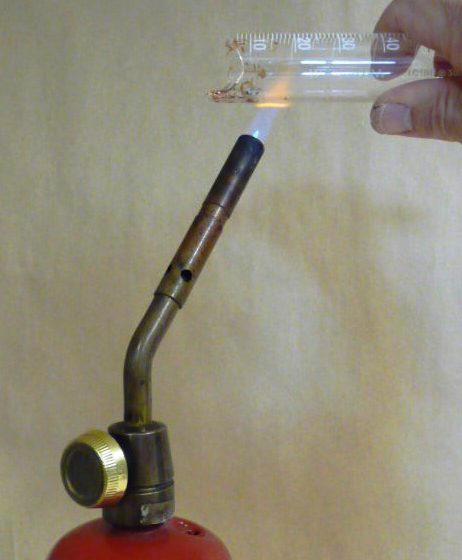
|
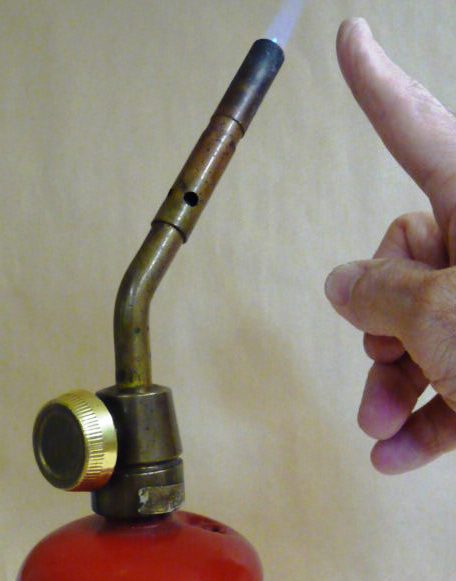
|
Copper is a good
conductor. You must move your fingers
several inches away from the end to keep from
getting burned.
|
Glass has much lower
thermal conductivity. You can hold onto
the glass just a couple of inches from the flame
and not feel any heat. Because energy is
not being carried away from the end of the piece
of glass, the glass can get hot enough to begin
to glow red.
|
You can put your
finger alongside the flame with just 1/2 inch or
so of separation. Air is a very poor
conductor. Don't put your finger above the
flame though.
|
Because air has such a low thermal conductivity it is
often used as an insulator.
It is important, however, to keep the air trapped in small
pockets or small volumes so that it isn't able to move and
transport energy by convection (we'll look at convection
momentarily). Here are some examples of insulators
that use air:
Foam is often used
as an insulator. Foam is filled with
lots of small air bubbles, that's what
provides the insulation.
You
can safely hold onto a foam cup filled with liquid nitrogen (-320 F)
because the foam does such a good job
insulating your fingers from the cold liquid
inside.
Thin insulating layer of air in a double pane
window. I
don't have double pane windows in my
house. As a matter of fact I leave a
window open so my cats can get in and out of
the house (that's not particularly energy
efficient). It also means there are
lots of mosquitoes in the house in the
summer.
We really
haven't needed winter coats yet in Tucson
this semester (rain coats yes but not winter
coats).
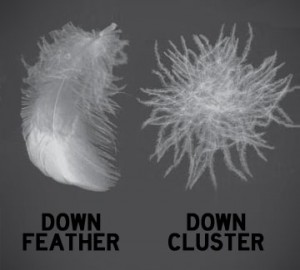
|

|
| Down
feathers are often used in coats
and sleeping bags. Packing together a
bunch of the "clusters" produces very good
insulation provided the feathers stay
"fluffed up" and trap air. source
of this image |
Synthetic fibers (Primaloft -
Synergy are shown above in a microphotograph) have
some advantages over down. There is
still some insulation when wet and the
material is hypoallergenic. source of
this image |
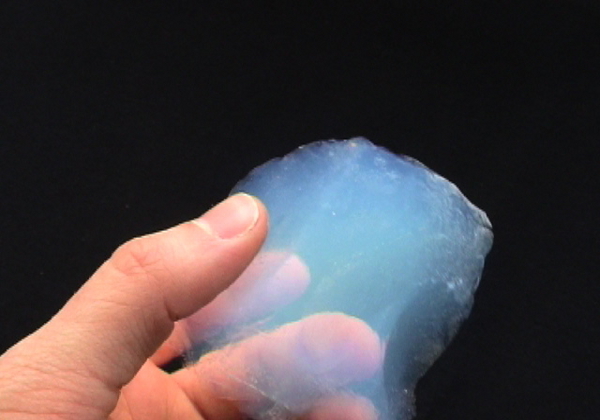 |
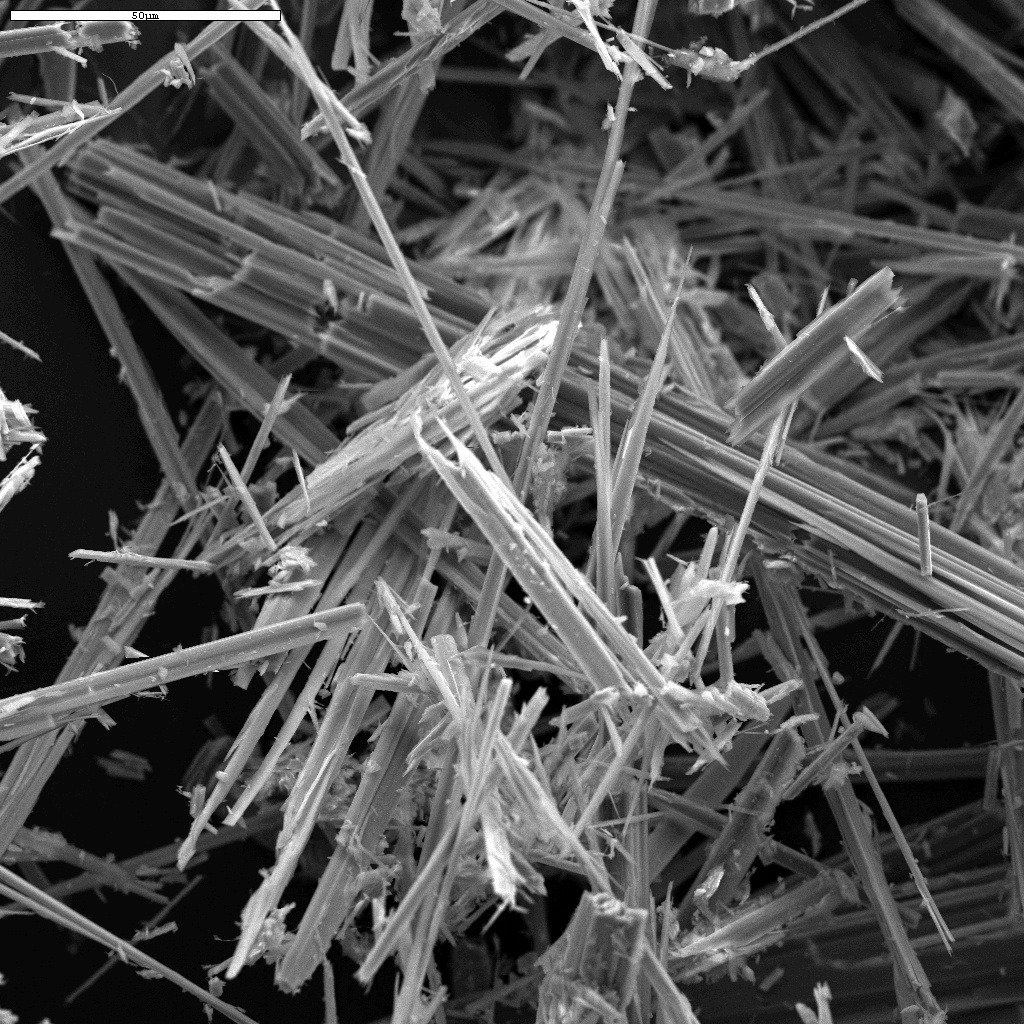
|
A
photograph of aerogel (image source),
sometimes known as solid air. It's
an excellent insulator because it is mostly
air. The small particles
in the aerogel are scattering light in the same
way air molecules do. That's why it has
this sky blue color.
|
A
scanning electron microscope photograph
of asbestos which was once widely used
as insulation. Asbestos
fibers can cause lung cancer and other
damage to your lungs when inhaled.
The white bar at the top left edge of
the image is 50 um across.
You can find this
image and read more about asbestos here.
|
8. Energy transport by convection
I used the torch to heat up the broken glass graduated
cylinder again. The glass gets so hot that you can see
it starting to glow red.
How would you cool off a hot object like this? You
could just hold onto it and it would eventually cool by
conduction. If you were in a little bit more of
a hurry you could blow on it. That's forced
convection, the energy transport process we will be
covering next. Or you could stick the hot end of the
cylinder into some water (you'd hear a short hissing sound
and the glass would probably shatter). The hissing
would mean the hot piece of glass had evaporated some
water. That would be an example of latent heat energy
transport which we'll be discussing later in the period.
Rather than moving about randomly, the atoms or molecules
move together as a group (organized motion). Convection
works in liquids and gases but not solids (the atoms or
molecules in a solid can't move freely).
At Point 1 in the picture
above a thin layer of air surrounding a hot object has
been heated by conduction. Then at Point 2 a person is
blowing the blob of warm air off to the right. The
warm air molecules are moving away at Point 3 from the hot
object together as a group (that's the organized part of
the motion). At Point 4 cooler air moves in and
surrounds the hot object and the whole process repeats
itself.
And actually you don't need to force convection, it
will often happen on its own.
A thin layer of air at
Point 1 in the figure above (lower left) is heated by
conduction. Then because hot air is also low density
air, it actually isn't necessary to blow on the hot
object, the warm air will rise by itself (Point 3).
Energy is being transported away from the hot object into
the cooler surrounding air. This is called free
convection. Cooler air moves in to take the place of
the rising air at Point 4 and the cycle repeats itself.
The example at upper right is also free convection.
Room temperature air in contact with a cold object loses
energy and becomes cold high density air. The sinking
air motions that would be found around a cold object have
the effect of transporting energy from the room temperature
surroundings to the colder object.
In both examples of free convection, energy is being
transported from hot toward cold.
I could put my finger alongside the flame from the
propane torch without any problem. There's very little
energy transported sideways through air by
conduction.

Be careful if you put
your finger or hand above the torch. That's
because there's a lot of very hot
air rising from the torch. This is energy
transport by free convection and its something you
can sometimes see.
Up at the front of the classroom you
might have been able to
see (barely) the shimmering of hot rising air
when I held the torch in front of the projector
screen. There is a technique, called
Schlieren photography, that can better catch
these barely visible air motions (it is able to
see and photograph the differences in air
density). The photo at right is an example
and shows the hot rising air above a candle.
The photo was taken by Gary Settles from
Penn State University and can be found at this
site.
9.
Real world examples of energy transport by
conduction and convection
Now some surprisingly practical applications, I think,
of what we have learned about conductive and convective
energy transport. Energy transport really does
show up in a lot more everyday real life situations than
you might expect.
Note first of all there is a temperature difference
between your hand and a room temperature (70 F)
object. Energy will flow from your warm hand to
the colder object. Metals are better conductors
than wood. If you touch a piece of 70 F metal it
will feel much colder than a piece of 70 F wood, even
though they both have the same temperature. A
piece of 70 F diamond would feel even colder because it
is an even better conductor than metal. A piece of
aluminum and a piece of wood (oak) were passed around
class so that you could check this out for yourself.
Something that feels cold may not be as cold as it
seems.
Our perception of cold
is more an indication of how quickly
our body or hand is losing energy
than a reliable measurement of
temperature.
Here's another
example
It's pleasant standing outside on a
nice day in 70 F air, it doesn't feel warm or
cold. But if you jump into 70 F pool water you
will feel cold, at least until you "get used to" the
water temperature (your body might reduce blood flow
to your extremities and skin to try to reduce energy
loss).
Air is a poor conductor. If you go out in 40
F weather you will feel cold largely because there is
a larger temperature difference between you and your
surroundings (and temperature difference is one of the
factors that affect rate of energy transport by
conduction).
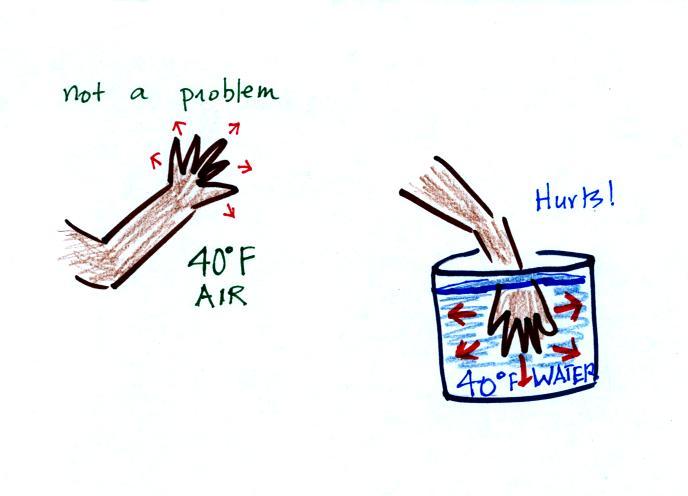
If you
stick your hand into a bucket of 40 F water, it will
feel very cold (your hand will actually soon begin to
hurt). Keep some warm water nearby to warm up
your hand.
Water is a much better conductor than air.
Energy flows much more rapidly from your hand into the
cold water. I mentioned in class that I thought
this might be good for you. The reason is that
successive application of hot and then cold is
sometimes used to treat arthritis
joint pain (it used to work wonders on my Dad's
knee).
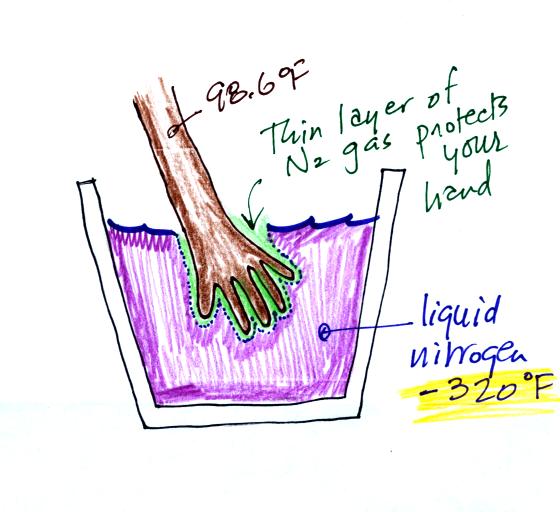
You can safely stick your hand into
liquid nitrogen for a fraction of a second.
There is an enormous temperature difference between
your hand and the liquid nitrogen which would
ordinarily cause energy to leave your hand at a
dangerously high rate (which could cause your hand to
freeze solid). It doesn't feel particularly cold
though and doesn't feel wet. The reason is that
some of the liquid nitrogen evaporates and quickly
surrounds your hand with a layer of nitrogen
gas. Just like air, nitrogen is a poor conductor
(air is mostly nitrogen). The nitrogen gas
insulates your hand from the cold for a very short
time (the gas is a poor conductor but a conductor
nonetheless) If you leave your hand in the
liquid nitrogen for even a few seconds it would
freeze. That would cause irreparable damage.
A question came up in class a few semesters ago
about sticking you hand (or maybe just the tip of one
finger) into molten lead. I've never seen it
done and certainly haven't tried it myself. But
I suspected that you would first need to wet your
hand. Then once you stick it into the lead the
water would vaporize and surround your hand with a
thin layer of gas, water vapor. The water vapor
is a poor conductor just like the nitrogen and oxygen
in air, and that protects your hand, for a short time,
from the intense heat. Here's a
video (and water does play a critical role)
Wind chill
Wind chill is a really good example of energy transport
by convection. As a matter of fact I'm hoping
that if I mention energy transport by convection that you'll
first think of wind chill. Wind chill is also a
reminder that our perception of cold is an indication of how
quickly our body is losing energy rather than an accurate
measurement of temperature.
Your body works hard to keep its
core temperature around 98.6 F. If
you go outside on a 40 F day (calm winds) you will
feel cool; your body is losing energy to the colder
surroundings (by conduction mainly). Your body
will be able to keep you warm for a little while
(perhaps indefinitely, I don't know). The 5
arrows represent the rate at which your body is losing
energy.
A thermometer behaves differently,
it is supposed to cool to the temperature of the
surroundings. Once it reaches 40 F and has the
same temperature as the air around it the energy loss
will stop. If your body cools to 40 F you will
die.

If you go outside on a 40 F day with 30 MPH winds your
body will lose energy at a more rapid rate (because
convection together with conduction are transporting energy
away from your body). Note the additional arrows drawn
on the figures above indicating the greater heat loss.
This higher rate of energy loss will make it feel colder
than a 40 F day with calm winds.
Actually, in terms of the rate at which your
body loses energy, the windy 40 F day would feel the
same as a 28 F day without any wind. Your body is
losing energy at the same rate in both cases (9 arrows
in both cases). The combination 40 F and 30
MPH winds results in a wind chill temperature of 28 F.
You would feel colder on a 40 F day with 30 MPH winds but
the actual temperature is still 40 F. The thermometer
will again cool to the temperature of its surroundings, it
will just cool more quickly on a windy day. Once the
thermometer reaches 40 F there won't be any additional
energy flow or further cooling. The thermometer would
measure 40 F on both the calm and the windy day.
Standing outside on a 40 F day is not an
immediate life threatening situation. Falling into
40 F water is, you'd last about 30 minutes (though you
might lose consciousness before that and die by
drowning).
Energy will be conducted away from your body
more quickly than your body can replace it. Your
core body temperature will drop and bring on hypothermia.
Be sure not to confuse hypothermia with hyperthermia
which can bring on heatstroke and is a serious outdoors
risk in S. Arizona in the summer.
Talk of how long you would last in 40 F water
reminds me of a page from National Geographic Magazine
that lists some of the limits
of human survival. I can't just scan the
original and add it to the notes without violating
copyright laws. But if you click on the link above
you'll find all of the same information online in the
form of a quiz.
I'm hoping to be able to cover latent heat energy
transport in class today also. But realistically I
suspect there won't be enough time. But I'll include
the notes anyways.
10. Latent heat energy transport
This is the 3rd and the
next-to-most important energy transport process
(probably also the hardest to understand).
If you had an object that you wanted to cool off
quickly the best thing might be to stick it into
some water. That would work first because
water will conduct energy more rapidly than
air. Also, and this is the most important
part, when a really hot object is immersed in water,
you'd probably hear a brief sizzling sound, the
sound of boiling water. A lot of energy would
be taken quickly from the hot object and used to
boil (evaporate) the water. The cooling in
this case takes only a few seconds. It's a
very potent energy transport process.
Latent heat energy transport is sometimes a
little hard to visualize or understand because the
energy is "hidden" in water vapor or water.
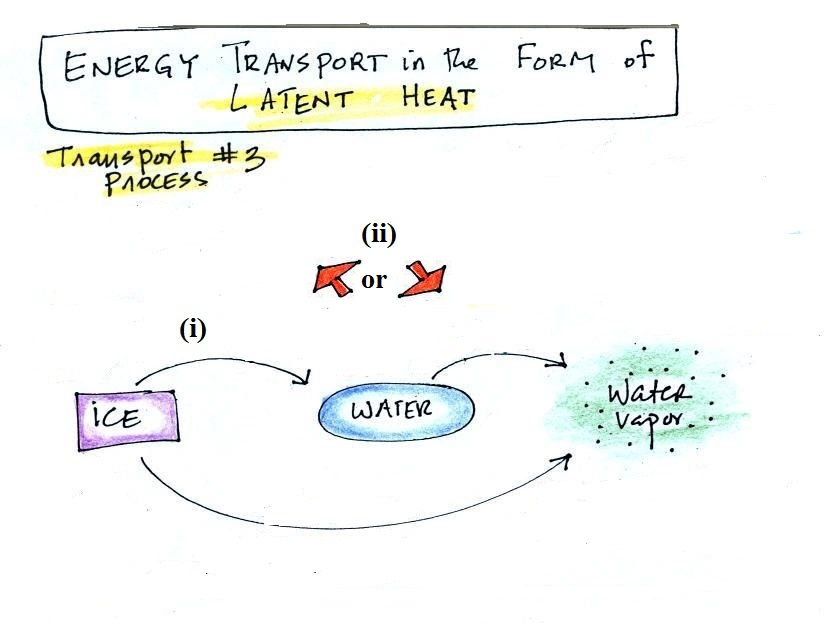
Latent heat energy
transport involves changes in phase or
state. You need to be able to add
two types of information to this picture
(this is p. 55 in the ClassNotes): (i) You
should be able to name each of the phase
changes shown above and (ii) You should also
be able to indicate whether energy must be
added to or removed from the material in
order for each phase change to take
place. And actually there is a third
thing, (iii), that we'll get to in a minute.

A solid to liquid phase
change is melting, liquid to gas is
evaporation, and sublimation is a solid to gas
phase change.
Dry ice is the best example of sublimation
that I can think of. When placed in a
warm room, dry ice turns directly from solid
carbon dioxide to gaseous carbon dioxide
without melting first. If you wash
clothes and stick them outside on a dry cold
(below freezing) day they will eventually
dry. The clothes would first freeze but
then the ice would slowly sublime away.
In each case above energy must be
added to the material changing phase.
You can consciously add or supply the energy
(such as when you put water in a pan and put
the pan on a hot stove and cause it to
boil).
That much is pretty clear. The
confusing part of this topic is when phase
changes occur without you playing any
role. Energy is still required to melt
ice; in this case the needed energy
will be taken from the surroundings.
It is not always obvious what the
"surroundings" are.
Here is the third thing to understand,
(iii). When energy is taken
from the surroundings, what effect will
that have on the surroundings?
When you take energy from the
surroundings, the surroundings will cool.
Here's an example
where you play the role of the
surroundings. You'll be able to feel
what happens when energy is taken from your
body and used to evaporate some water.
When you step out of the shower in the morning
you're covered with water. Some of the water
evaporates. It doesn't ask permission, it
just evaporates whether you want it to or
not. The energy needed for evaporation is
taken from the surroundings, from your body.
Because your body is losing energy you feel cold.
The object of this figure is to give you some
appreciation for the amount of energy involved in
phase changes. A 240 pound man or woman
running at 20 MPH has just enough kinetic energy
(if you could capture it) to be able to melt an
ordinary ice cube (I have been using Tedy
Bruschi as an example for several years but
he's now retired so I have switched to Scooby
Wright). It would take 8 people
running at 20 MPH to evaporate the resulting ice
water.
Latent heat energy is energy that is hidden in
water or water vapor. We can
now start to visualize what that means and how that
works.

|

|
Energy added to melt the
ice is hidden in the water that results
(instead of the arrow hidden in the water
you could draw in one Scooby Wright running
at full speed).
|
Energy added
to evaporate the water is added to the
energy already in the water and is
hidden in the water vapor
|
 |
Phase changes can go in the other direction
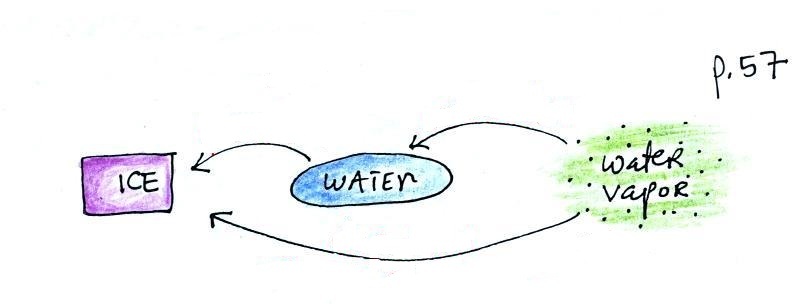
Again (i) try to name each
phase change and (ii) show the direction of
energy flow (into or out of the material) when
the phase change occurs
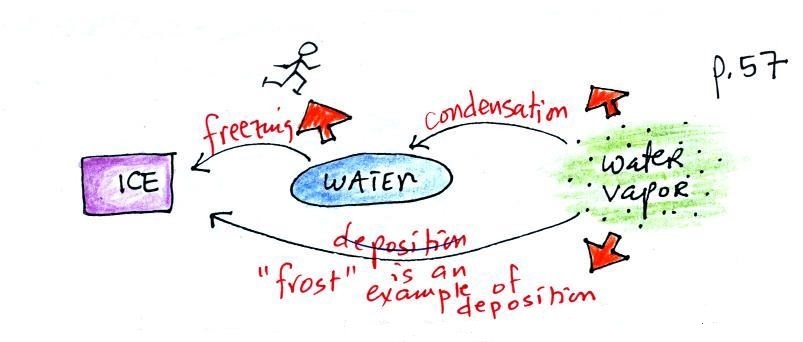
You might not have heard of
deposition before when a gas changes directly to
a solid. The formation of frost is an
example of deposition.
You can consciously remove energy from water
vapor to make it condense. You take energy
out of water to cause it to freeze (you could
put water in a freezer; energy would flow
from the relatively warm water to the colder
surroundings). If one of these phase
changes occurs, without you playing a role,
energy will be released into the surroundings
(causing the surroundings to warm).
Note the direction of the energy arrows -
energy is being released into the surroundings
(warming the surroundings). It's kind of
like a genie coming out of a magic lamp.
One Scooby Wright worth of kinetic energy is
released when enough water freezes to make an
ice cube. Many Scooby Wrights are released
when water vapor condenses.
This release of energy into the
surroundings and the warming of the surroundings
is a little harder for us to appreciate because
it never really happens to us in a way that we
can feel. Have you ever stepped out of an
air conditioned building into warm moist air
outdoors and had your glasses or sunglasses
"steam up"? Water vapor never condenses
onto your body (your body is too warm).
However if it did you would feel warm. It
would be just the opposite of the cold feeling
when you step out of the shower or a pool and
the water on your body evaporates. You
know how cold the evaporation can make you feel,
the same amount of condensation would produce a
lot of warming. I suspect we'd
be surprised at how much warming it produces.
Alternate
view showing the latent heat energy in
water vapor and water coming out of
hiding during a phase change and being
released into the surroundings.
Here's a practical application of what we
have been learning.
Cans of a cold drink are taken out of the
refrigerator and placed on the kitchen table
on a warm dry day and a warm humid
day. Except for the differences
in the amount of moisture in the air
everything else is the same.
Moisture has condensed onto the can above at
right. Do the two cans warm up at the
same rate or does one warm up more quickly
than the other. In the latter case
which can warms up most rapidly.
The can on the right will warm more
quickly. Equal amounts of heat will
flow from the warm air into the cold cans in
both cases. Condensation of water
vapor is an additional source of energy and
will warm that can more rapidly. I
suspect that the condensation may actually
be the dominant process.
The foam "cozy", "koozie",
or whatever you want to call it, that you
can put around a can of soda or beer is
designed to insulate the can from the warmer
surroundings but also, and probably more
importantly, to keep water vapor in the air
from condensing onto the can (source
of the image above)
We're beating
this concept to death but we're almost
done. Two more figures to illustrate
how latent heat energy transport can carry
energy from location to another.
This first one is my favorite, it ties
everything together.
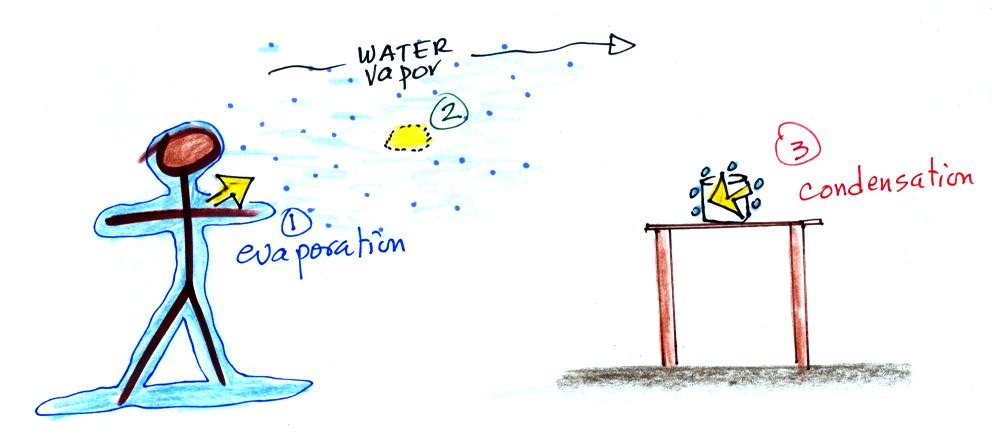
1. You've just stepped
out of the shower and are covered with
water. The water is evaporating and energy
is being taken from your body.
2. The water vapor (containing the energy
taken from your body), drifts into the kitchen
where it finds a cold can sitting on a
table.
3. Water vapor comes into contact with the
cold can and condenses. The hidden latent
heat energy in the water vapor is released into
the can and warms the drink inside.
Without you
even leaving the bathroom,
energy has effectively been transported
from your warm body to the cold can in the
kitchen.
Here's what happens on a much grander scale in
the atmosphere.
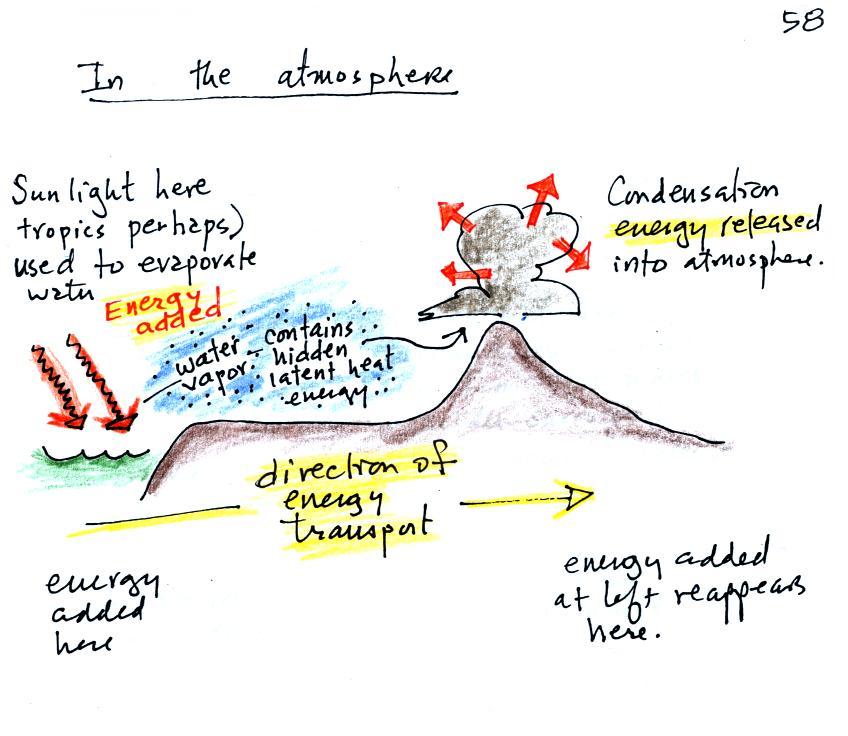
Here are scanned images of the lecture outline or
summary sheet with some of the main details filled
in.
